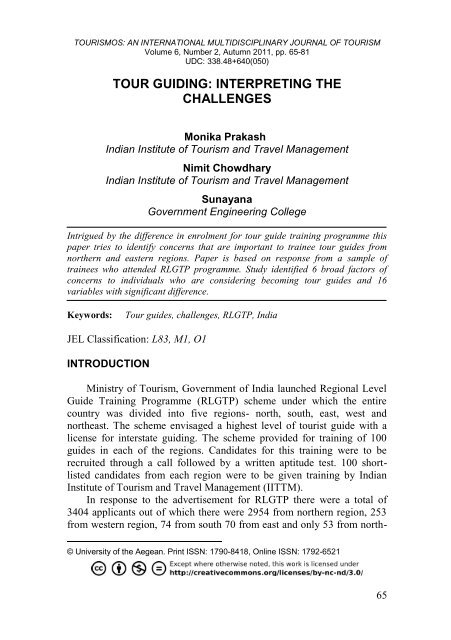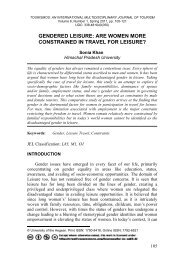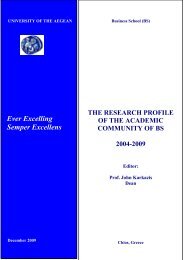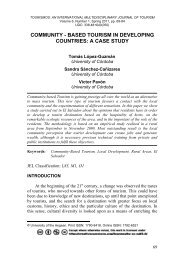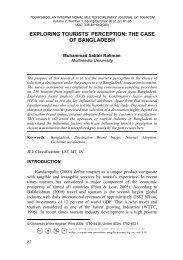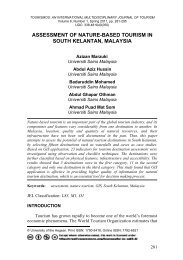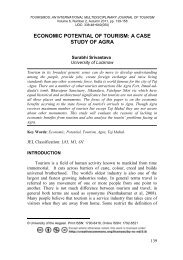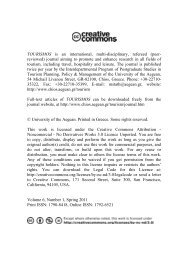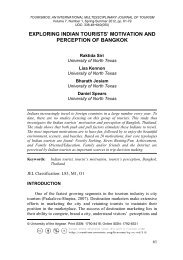TOUR GUIDING: INTERPRETING THE CHALLENGES
TOUR GUIDING: INTERPRETING THE CHALLENGES
TOUR GUIDING: INTERPRETING THE CHALLENGES
Create successful ePaper yourself
Turn your PDF publications into a flip-book with our unique Google optimized e-Paper software.
<strong>TOUR</strong>ISMOS: AN INTERNATIONAL MULTIDISCIPLINARY JOURNAL OF <strong>TOUR</strong>ISM<br />
Volume 6, Number 2, Autumn 2011, pp. 65-81<br />
UDC: 338.48+640(050)<br />
<strong>TOUR</strong> <strong>GUIDING</strong>: <strong>INTERPRETING</strong> <strong>THE</strong><br />
<strong>CHALLENGES</strong><br />
Monika Prakash 1<br />
Indian Institute of Tourism and Travel Management<br />
Nimit Chowdhary<br />
Indian Institute of Tourism and Travel Management<br />
Sunayana<br />
Government Engineering College<br />
Intrigued by the difference in enrolment for tour guide training programme this<br />
paper tries to identify concerns that are important to trainee tour guides from<br />
northern and eastern regions. Paper is based on response from a sample of<br />
trainees who attended RLGTP programme. Study identified 6 broad factors of<br />
concerns to individuals who are considering becoming tour guides and 16<br />
variables with significant difference.<br />
Keywords:<br />
Tour guides, challenges, RLGTP, India<br />
JEL Classification: L83, M1, O1<br />
INTRODUCTION<br />
Ministry of Tourism, Government of India launched Regional Level<br />
Guide Training Programme (RLGTP) scheme under which the entire<br />
country was divided into five regions- north, south, east, west and<br />
northeast. The scheme envisaged a highest level of tourist guide with a<br />
license for interstate guiding. The scheme provided for training of 100<br />
guides in each of the regions. Candidates for this training were to be<br />
recruited through a call followed by a written aptitude test. 100 shortlisted<br />
candidates from each region were to be given training by Indian<br />
Institute of Tourism and Travel Management (IITTM).<br />
In response to the advertisement for RLGTP there were a total of<br />
3404 applicants out of which there were 2954 from northern region, 253<br />
from western region, 74 from south 70 from east and only 53 from north-<br />
© University of the Aegean. Print ISSN: 1790-8418, Online ISSN: 1792-6521<br />
65
Monika Prakash, Nimit Chowdhary & Sunayana<br />
eastern region 2 . This was an unexpected distribution that merited<br />
investigation into the reasons for much less than expected response form<br />
four regions. A research question that emerged is why are lesser number<br />
of people interested in becoming tour guides in these four regions? Is<br />
there a difference in motivation? Is there a perceived difficulty in this<br />
profession? This paper delves with the second issue and tries to identify<br />
apprehensions that trainee tourist guides have. Having identified these<br />
apprehension policy makers may bring in necessary interventions so that<br />
perceived risks of entering the profession are lowered and more of<br />
talented individuals are attracted. Clearly there is more competition in<br />
northern region as compared to other regions.<br />
LITERATURE REVIEW<br />
Tour guides may be the most maligned people in the world of travel.<br />
They are blamed for the problems of travel, such as bad weather and<br />
traffic jams (Ang, 1990). Being present in person before a tourist they are<br />
expected to solve all problems of tourist- within or outside of their<br />
control. Failure to do so is considered as a poor performance. This is<br />
unjust as well as challenging. Ang (1990) therefore points out that tour<br />
guides are „buffers‟ between the tourist and the site visited.<br />
There are very few studies about the professional status and issues<br />
faced by tour guiding profession that have been reported in the Englishbased<br />
literature (Holloway, 1981; Ap and Wong, 2001). Zhang and Chow<br />
(2004) have also reported that there have been very few research studies<br />
on tour guides (Almagor 1985; Cohen 1982, 1985; Fine and Speer, 1985;<br />
Katz, 1985; Pearce 1984; El-Sharkawy, 2007; Skanavis and Giannoulis,<br />
2010). However, there have been comments and observations by a few<br />
researchers but not exactly while studying challenges faced by tour<br />
guides.<br />
Cheong and Miller (2000), assert that travel agents, hoteliers, tour<br />
guides, and vendors constrain tourists‟ movements, behaviours, and even<br />
thoughts. The structures described here so not just constrain but enable<br />
and make tourism possible. While these structures are provided to<br />
tourists, tourist adapts them to their own use (Brown, 2007). Thus all<br />
these service-provides contribute to customers‟ satisfaction or<br />
dissatisfaction, whereas tour guides often face the brunt.<br />
Summarising their study on tour guiding in Hong Kong, Ap and<br />
Wong (2001), have identified that there was no training course for new<br />
2<br />
66<br />
Source: IITTM‟s internal data.
<strong>TOUR</strong>ISMOS: AN INTERNATIONAL MULTIDISCIPLINARY JOURNAL OF <strong>TOUR</strong>ISM<br />
Volume 6, Number 2, Autumn 2011, pp. 65-81<br />
UDC: 338.48+640(050)<br />
entrants and there was a lack of training opportunities which resulted in to<br />
variable levels of professionalism, lack of recognition and a poor image of<br />
profession. Other challenges include potential problems resulting from<br />
unhealthy industry practices; need for a certification, registration or<br />
licensing system; absence of any monitoring of tour guide performance;<br />
and more active and visible role to be taken by the local tour guiding<br />
association.<br />
Tour guides must address multiple stake holders simultaneously.<br />
Visitors expect that their safety and health will take a high priority, but at<br />
the same time expect an enjoyable and rewarding travel experience. Some<br />
have special needs and expectations associated with their particular<br />
cultural background, their physical and intellectual capabilities, and their<br />
passions and interests in particular subject matters (Weiler and Ham,<br />
2002). Employers expect the guide to provide high-quality service to<br />
visitors in order to meet these expectations, as well as to manage the<br />
group, the itinerary and other logistical aspects of the experience to<br />
maximise not only visitor satisfaction but also profit margins (Cohen,<br />
1985: Pond, 1993).<br />
Tour guides face challenges both from within and from their<br />
operating context. Guides may have personal limitations of skills,<br />
competences, etc. Externally, they must also subscribe to rules and<br />
regulations of their areas of operations, their employers and their clients.<br />
The guides are often pressed for time, caught between their obligation to<br />
please their employers and the tourists, and subject to government<br />
regulations (Dahles, 2002; Dritsas, 2006).<br />
Governments at all levels have realised the importance of tourism as<br />
an intervention for achieving socio-economic-political goals.<br />
Governments, therefore, have gotten interested in controlling tourism to<br />
fall in line with their agenda. In reference to tourism, this percolates down<br />
to controlling and modifying tour-guides‟ working and behaviour to meet<br />
its interests (like creating a positive image of destination, positive image<br />
of the government, etc.). However, there is an inherent dissonance<br />
between, intentions of governments and DMOs, interest of employers<br />
(tour companies), motivations of tour guides and expectations of tourists.<br />
However, a trend is visible. At destinations in „growing‟ phase there<br />
appears to be more government control which gets reduced as competition<br />
at destination matures with significant participation of private players.<br />
Interaction between the control regime and demand –supply equation<br />
of trained manpower also affects the working of tour guides. For example<br />
in India, the demand-supply equation is very different for different<br />
regions. In northern regions the supply of tour guides appears to exceed<br />
67
Monika Prakash, Nimit Chowdhary & Sunayana<br />
the demand; whereas in other regions demand far exceeds the supply.<br />
Therefore, in northern region, guiding without a proper license is<br />
generally perceived as a threat to the state‟s carefully crafted image of<br />
tamed cultural diversity, professionalism promised uniformity, and central<br />
control- an observation also reported by Adam (1997) about early days of<br />
state control of tour guide licensing in Yogyakarta region of Indonesia.<br />
Here government regulations are considered as instrument for<br />
protectionism in the established industry. While it reduces opportunities<br />
for unlicensed guides to acquire professional status, it also provides for<br />
stricter control of the practices of licensed guides. On the other hand, in<br />
other tourism regions of India, tour guide training and licensing is<br />
considered an upgrading intervention that is perceived as an opportunity<br />
for practicing unlicensed guides as well as those who are new entrants to<br />
trade. This is as reported by Bras (2000) in case of Lombok.<br />
Opinion on social status of tour guides is divided. Most of the<br />
reported work is drawn from developed countries‟ context. It might not be<br />
applicable in cases of developing countries. While Elkan (1975) reported<br />
that tourism employment in such areas (Africa) is thought by some to be<br />
low status and therefore degrading and demeaning. Cukier (1998) held a<br />
differing view. According to her, opportunities for work in the tourism<br />
sector in developing countries are often accorded a relatively high status<br />
by the local population. Reasons include the relatively high salary of<br />
tourism occupations (even those within the informal sector), the relative<br />
physical ease of many tourism occupations when compared to traditional<br />
primary sector occupations (e.g. agricultural labours). She also noted that<br />
in Southeast Asia in particular, local cultures place high value on „service‟<br />
towards others, a situation reflected in relatively high status accorded to<br />
tourism occupations. Cuckier also cited Pongsapich (1982) who noted<br />
that in Thailand, young people who are fluent in English or other foreign<br />
languages often became guides, apposition that was considered to be a<br />
good job in terms of both pay and status. According to her „guiding‟, an<br />
informal job, ranked higher in status than many other formal tourism<br />
occupations such as business tables, washing dishes, or working as a<br />
janitor.<br />
RESEARCH<br />
Research attempted a comparison of challenges as perceived by tour<br />
guides in northern and eastern regions of India. In the first phase of<br />
research it was decided to free list the perceived challenges. Researchers<br />
posed a question to potential candidates who wanted to become tour<br />
68
<strong>TOUR</strong>ISMOS: AN INTERNATIONAL MULTIDISCIPLINARY JOURNAL OF <strong>TOUR</strong>ISM<br />
Volume 6, Number 2, Autumn 2011, pp. 65-81<br />
UDC: 338.48+640(050)<br />
guides a single question: “What do you think would be the challenges in<br />
your initial days as a tour guide?” A free list of 53 motivations was<br />
developed. Interestingly the list included both individual and external<br />
factors. Individual factors are those related to the guide, whereas the<br />
external factors are those related to his/ her work environment. This list<br />
was presented to a panel of experts who eliminated redundancy and<br />
reduced this list to 31(See Table 1).<br />
Table 1 Perceived challenges tour guides may face<br />
Challenge Description Label<br />
C1 Limited knowledge about tourism product/ destination NKNOW<br />
C2 Inability to meet expectations of a demanding tourist NEXPECT<br />
C3 There are no fixed salaries to take home NVARSLRY<br />
C4 Dependence on travel agents NTRVLAGT<br />
C5 Competition with established senior guides NCOMPT<br />
C6 (Unfair)competition from unauthorized guides NAUTHO<br />
C7 Will have to develop connections to tap tourists NNETWORK<br />
C8 There are many unscrupulous elements in the trade NANTISOCIAL<br />
C9 Can do little to ensure security of my tourist NSECURE<br />
C10 People do not trust tour guides NTRUST<br />
C11 Travel agents ask for commissions NCOMM<br />
C12 My area of activity is less known to tourists NINFO<br />
C13<br />
C14<br />
C15<br />
C16<br />
C17<br />
There are few good quality accommodation for<br />
tourists<br />
Poor connectivity with other areas with tourism<br />
potential<br />
Local public/ anti social elements do not treat tourists<br />
properly<br />
Tourists are apprehensive of entering improperly<br />
maintained monuments<br />
Dearth of civic facilities including toilets and fresh<br />
rooms for tourists<br />
NACCOMO<br />
NCONNECT<br />
NTREAT<br />
NMONUMENT<br />
NCIVIC<br />
C18 Guiding alone insufficient to maintain a family NINCOME<br />
C19 Staffs at monuments do not treat guides respectfully NSTAFF<br />
C20 Even guides have to purchase tickets at monuments NTICKET<br />
C21 There are no incentives for doing a good guiding job NINCENT<br />
C22 Not conversant with foreign language NLANG<br />
69
Monika Prakash, Nimit Chowdhary & Sunayana<br />
C23 There is little support from government NSUPP<br />
C24 Not confident how to express my knowledge NCONFKNOW<br />
C25 Not confident of my presentation skills NCONPRSNT<br />
C26 The trains and surface transport are often late NTRANSPORT<br />
C27 Young guides get poor payments for their jobs NPAY<br />
C28<br />
C29<br />
At times false criminal allegations are levelled against<br />
guides<br />
There are pressures to do work which may not be<br />
legal<br />
NALLEG<br />
NLEGAL<br />
C30 Tourist show little respect for the guides NRESPECT<br />
C31<br />
It is difficult to help out the tourists at the time of<br />
crisis<br />
NHELP<br />
Two sets of bilingual instruments were developed with these 31 items<br />
to ascertain validity. For northern region instrument was in English and<br />
Hindi, whereas for eastern region it was in English and the vernacular.<br />
Respondents were asked to mark their choices on a five point Likert-type<br />
scale. The instruments were administered to samples of tourist guide<br />
trainees in two regions (65 in northern region and 65 in eastern region).<br />
60 responses in northern region and 45 in eastern region were received.<br />
Of these 56 from northern region and 44 from eastern region (total 100)<br />
were usable.<br />
RESULTS AND DISCUSSION<br />
One of the important outcomes was the descriptive statistics about<br />
the apprehensions that tourguides had. The mean varied between 2.08 to<br />
3.59 on a five-point (1-5) scale with „1‟ indicating strong disagreement<br />
and „5‟ indicating strong agreement with the statement. So larger the<br />
value of rating on the scale more does respondent agree with the<br />
statement. Since these were apprehensions the mean was not close to 5<br />
even for the top five perceived challenges. However, it may be noted that<br />
all variables (had slightly higher standard deviation between 1.1031 and<br />
1.247. This indicates that these are apprehensions and display variability<br />
as expected (See Table 2).<br />
As indicated in the beginning of the paper there is more competition<br />
in the northern region. This is especially on the „golden triangle3‟ circuit.<br />
Tourism is gradually picking up in the eastern region and is gradually<br />
3<br />
70<br />
Golden triangle refers to the popular tourist circuit- Delhi-Jaipur-Agra in the northern region.
<strong>TOUR</strong>ISMOS: AN INTERNATIONAL MULTIDISCIPLINARY JOURNAL OF <strong>TOUR</strong>ISM<br />
Volume 6, Number 2, Autumn 2011, pp. 65-81<br />
UDC: 338.48+640(050)<br />
becoming more professional. This is also reflected in apprehensions that<br />
tour guides, who are one of the important service providers, have. In<br />
eastern region they are more concerned with personal competencies<br />
which they must soon develop as tourism gets competitive in the east.<br />
Concerns include lack of confidence as far as presentation skills and<br />
knowledge of tourism is concerned. They are also concerned about their<br />
inability to meet the expectations of tourist. They are also uneasy about<br />
their ability to ensure security of their tourist. However in north, business<br />
related issues are part of their concern.<br />
Table 2 Top five apprehensions (combined)<br />
Challenge Description Rank Mean S.D.<br />
C25 Not confident of my presentation skills 1 3.59 1.12<br />
C24 Not confident how to express my knowledge 2 3.57 1.19<br />
C30 Tourist show little respect for the guide 3 3.51 1.14<br />
C20<br />
C31<br />
Even guides have to purchase tickets at the<br />
monuments<br />
It is difficult to help out the tourists at the time<br />
of crisis<br />
4 3.39 1.22<br />
5 3.35 1.14<br />
Respondents from north are particularly unhappy about the fact that<br />
even recognized tour guides have to buy tickets at certain monuments.<br />
Unavailability of good quality accommodation for their tourists is a cause<br />
of worry for them. Northern India has some of the best hotels in the<br />
world. Accommodation sector is very competitive here but tourism in<br />
India is on rise and a large share of tourist visit north and so the supply,<br />
both quantitatively and qualitatively, fall short of demand. Because of this<br />
heavy tourist traffic on certain circuits in north a lot of unauthorized,<br />
untrained and unrecognized players have come in. They are offering poor<br />
services and some unscrupulous elements are even engaged in illegal<br />
activities. Thus there is a lost of trust and respect for tour guides in this<br />
region. These are also of concern to respondents from north. Respondents<br />
are also unhappy about their inability to help tourist when in crisis.<br />
Table 3 Top five apprehension of tour guides(region-wise)<br />
North<br />
East<br />
Rank Apprehension Rank Apprehension<br />
1 Even guides have to purchase 1 Not confident of my<br />
tickets at the monuments (C20) presentation skills (C25)<br />
2 There are few good quality 2 Not confident how to express<br />
71
Monika Prakash, Nimit Chowdhary & Sunayana<br />
accommodations for the tourists my knowledge (C24)<br />
(C13)<br />
3 It is difficult to help out the<br />
tourists at the time of crisis (C31)<br />
3 Tourist show little respect for<br />
the guides (C30)<br />
4 People do not trust guides (C10) 4 Inability to meet expectations of<br />
a demanding tourist (C2)<br />
4 Tourist show little respect for the<br />
guides (C30)<br />
5 Can do little to ensure security<br />
of my tourist (C9)<br />
5 Not confident of my presentation<br />
skills (C25)<br />
6 There are pressures to do work<br />
which may not be legal (C29)<br />
Independent sample t-test was conducted for difference of means for<br />
all 31 variables between the responses from north and east. There was<br />
significant difference (at 5%) in responses for 16 variables. In 8 cases<br />
respondents from north were more concerned and in other 8 cases<br />
respondents from east were more concerned (see table 4).<br />
72<br />
Table 4 Significant difference in responses<br />
Variable North East<br />
Variables where respondents from north are more concerned<br />
C20<br />
C13<br />
Even guides have to purchase tickets at<br />
monuments<br />
There are few good quality accommodation for<br />
tourists<br />
μ σ μ Σ<br />
3.71 1.25 2.66 1.06<br />
3.48 1.26 2.91 1.22<br />
C10 People do not trust tour guides 3.40 1.27 2.86 1.15<br />
C21<br />
There are no incentives for doing a good guiding<br />
job<br />
3.15 1.23 2.57 1.28<br />
C18 Guiding alone insufficient to maintain a family 2.98 1.31 2.32 1.12<br />
C15<br />
C14<br />
C17<br />
Local public/ anti social elements do not treat<br />
tourists properly<br />
Poor connectivity with other areas with tourism<br />
potential<br />
Dearth of civic facilities including toilets and<br />
fresh rooms for tourists<br />
Variables where respondents from east are more concerned<br />
2.85 1.26 2.23 1.00<br />
2.73 1.38 2.00 1.01<br />
2.55 1.31 1.95 0.81<br />
C24 Not confident how to express my knowledge 3.28 1.28 4.07 0.93<br />
C25 Not confident of my presentation skills 3.36 1.16 3.84 1.16<br />
C2<br />
Inability to meet expectations of a demanding<br />
tourist<br />
2.86 1.27 3.43 1.02<br />
C11 Travel agents ask for commissions 2.20 1.10 2.91 1.15<br />
C1 Limited knowledge about tourism product/ 2.09 1.00 2.57 1.23
<strong>TOUR</strong>ISMOS: AN INTERNATIONAL MULTIDISCIPLINARY JOURNAL OF <strong>TOUR</strong>ISM<br />
Volume 6, Number 2, Autumn 2011, pp. 65-81<br />
UDC: 338.48+640(050)<br />
destination<br />
C22 Not conversant with foreign language 1.96 1.18 2.48 1.30<br />
C5 Competition with established senior guides 1.95 1.17 2.45 1.23<br />
C3 There are no fixed salaries to take home 1.80 0.92 2.30 1.28<br />
Analysis of factors<br />
The range of means values of variables was relatively small and the<br />
dispersion for many variables was close to 1 or more. To understand the<br />
variability and reduce the number of variables, factor analysis using the<br />
principal component method of extraction was used. To establish the<br />
suitability of data for factor analysis Kaiser-Meyer-Olkin Measure of<br />
Sampling Adequacy (MSA) and Barlett‟s test of sphericity were carried<br />
out. Value of KMO-MSA statistic for the data was 0.571 which was<br />
higher than 0.500. Though the MSA is not very good still factors would<br />
suitable explain variance in variables. Significance level of 0.000 in<br />
Barlett‟s test of sphericity indicates that there are probably significant<br />
relationships among the variables.<br />
Anti-image correlation matrix was analysed along the diagonal for<br />
MSA of individual items. Values less than „0.5‟ may indicate variables<br />
that do not seem to fit with the structure of the other variables. It was<br />
decided to drop variables with MSA less than 0.5 from Factor Analysis.<br />
Five variables had MSA less than 0.5- „Inability to meet expectations of a<br />
demanding tourist‟, „Dependence on travel agents‟, „Tourists are<br />
apprehensive of entering improperly maintained monuments‟, „There is<br />
little support from government‟, and‟ Not confident how to express my<br />
knowledge‟.<br />
Factor analysis for 26 variables using principal component method<br />
was used to extract Eigenvalues greater than 1 allowing up to 50 iterations<br />
for convergence (see Table 5).<br />
Table 5 Variance explained by factors<br />
Initial Eigenvalues 4<br />
Factors Total % of Cum. %<br />
Variance<br />
1 5.146 19.791 19.791<br />
2 2.755 10.596 30.387<br />
3 1.842 7.084 37.471<br />
4<br />
(first 9 components with Eigen values greater than 1)<br />
73
Monika Prakash, Nimit Chowdhary & Sunayana<br />
4 1.829 7.034 44.505<br />
5 1.629 6.265 50.770<br />
6 1.280 4.922 55.692<br />
7 1.264 4.862 60.555<br />
8 1.172 4.509 65.064<br />
9 1.145 4.405 69.469<br />
10 .860 3.309 72.778<br />
11 .856 3.293 76.071<br />
Cases were excluded list-wise to take account for missing values.<br />
Correlation matrix for 26 items did not return any coefficient more than<br />
0.5, so all the 26 items were included in the factor analysis. A 9-factor<br />
solution explaining 69.47% of total variance appeared most interpretable.<br />
The factors based on component matrix were not readily interpretable. 14<br />
variables were grouped under one factor where as at least 2 factors did not<br />
have any variables. One variable (NSECURE) was loaded equally on two<br />
factors. However, rotated component matrix gave a more interpretable<br />
solution. However, the solution did not appear to be logical or<br />
convincing. Therefore, a panel of experts was asked to group variables in<br />
to seemingly logical factors. Panel suggested a 6 factor solution (see table<br />
6). These factors include: Unattractiveness of job (UNATRCT) which<br />
includes pre induction apprehensions of trainee tour guides; Skill deficit<br />
(SKLDFCT) that reflects a potential tour guides‟ apprehensions about his/<br />
her capabilities to be tour guides; Perceived occupational challenges<br />
(OCCUCHAL) that includes apparent challenges that a tour guide may<br />
have to face- these included business/ profession related direct challenges;<br />
Quality of Job (JOBQUAL) issues that they might have to face while<br />
working as tourguides- more related with respect and dignity of a tour<br />
guide; Tourism Infrastructure (<strong>TOUR</strong>INFR) factor reflects discomfort of<br />
respondents with tourism infrastructure which they perceive as a<br />
challenge that would affect their business/ performance adversely; and,<br />
External threats (EXTNTHRT) which includes factors that respondents<br />
consider as external and beyond the normal control of an individual.<br />
Weighted averages were computed for the six factors (See table 7 and<br />
figure 1). Most factors are less than 3 on a 5 point scale that shows<br />
respondents are not really concerned about the challenges. The disposition<br />
in general is positive.<br />
74
<strong>TOUR</strong>ISMOS: AN INTERNATIONAL MULTIDISCIPLINARY JOURNAL OF <strong>TOUR</strong>ISM<br />
Volume 6, Number 2, Autumn 2011, pp. 65-81<br />
UDC: 338.48+640(050)<br />
Factor 1: Un-attractive job<br />
C3<br />
C18<br />
C21<br />
C27<br />
Table 6 Suggested 6-factor solution<br />
There are no fixed salaries to take home<br />
Guiding alone is insufficient to maintain a family<br />
There are no incentives for doing a good job<br />
Young guides get poor payments for there jobs<br />
Factor 2: Skill deficit<br />
C1<br />
C22<br />
C24<br />
C25<br />
Limited knowledge about tourism products/ destination<br />
Not conversant with foreign language<br />
Not confident how to express my knowledge<br />
Not confident of my presentation skills<br />
Factor 3: Perceived occupational challenges<br />
C2<br />
C5<br />
C6<br />
C7<br />
C8<br />
C11<br />
C20<br />
Inability to meet expectations of a demanding tourists<br />
Competition with established senior guides<br />
(Unfair) competition from authorized guides<br />
We will have to develop connections to tap tourists<br />
There are many unscrupulous elements in the trade<br />
Travel agents ask for commissions<br />
Even guides have to purchase tickets at the monuments<br />
Factor 4: Quality of job<br />
C10<br />
C15<br />
C19<br />
C29<br />
C30<br />
People do not trust tour guides<br />
Local public/ anti social elements do not treat tourists respectfully<br />
Staffs at monuments do not treat guides respectfully<br />
There are pressures to do work which may not be legal<br />
Tourist show little respect for the guide<br />
Factor 5: Tourism infrastructure<br />
C13<br />
C14<br />
C16<br />
C17<br />
C26<br />
There are few good quality accommodations for tourists<br />
Poor connectivity with other areas with tourism potential<br />
Tourists are apprehensive of entering improperly maintained monuments<br />
Dearth of civic facilities, including toilets and fresh rooms for tourists<br />
The trains and surface transport are often late<br />
Factor 6: External threats<br />
C4<br />
C9<br />
C12<br />
Dependence on travel agents<br />
Can do little to ensure security of my tourist<br />
My area of activity is lesser know to tourists<br />
75
Monika Prakash, Nimit Chowdhary & Sunayana<br />
C23<br />
C28<br />
C31<br />
There is little support from government<br />
At times criminal allegations are levelled against guides<br />
It is difficult to help out tourists at the time of crisis<br />
Figure 1: Percieved Challenges<br />
EXTNTHRT<br />
<strong>TOUR</strong>INFR<br />
JOBQUAL<br />
OCCUCHAL<br />
SKLDFCT<br />
UNATRCT<br />
0 0.5 1 1.5 2 2.5 3 3.5<br />
5 point scale<br />
North<br />
East<br />
However, skill deficit, quality of job and external threats appears to<br />
be of some concerns to the respondents. Skill deficit is the most important<br />
concern. Further, t-test suggests that there is a significant difference<br />
between the responses from eastern and northern regions. Respondents<br />
from eastern region feel that they lack necessary skills to be tour guides.<br />
Close to this factor, challenges of trade are the other factor where<br />
respondents from east are more concerned as compared to respondent<br />
from north. For all other factors respondents from north are more<br />
concerned. This is perhaps because of excessive competition in the<br />
northern region. Competition, which is largely in the unorganized sector,<br />
poses challenges that are difficult for the potential tour guide to handle as<br />
an individual. Survival based on tour guiding alone is difficult. Moreover,<br />
tourism is seasonal, restricted to 6 months and could be stretched by<br />
another 2 months. Because of popular tourist circuits in north a lot of<br />
tourism operators largely in the unorganized sector have been providing<br />
services to tourists. A lot of unauthorized guides have come-up and<br />
operate mainly for commissions they get from other sellers that<br />
accompanying tourists patronize. These un-authorized guides are<br />
76
<strong>TOUR</strong>ISMOS: AN INTERNATIONAL MULTIDISCIPLINARY JOURNAL OF <strong>TOUR</strong>ISM<br />
Volume 6, Number 2, Autumn 2011, pp. 65-81<br />
UDC: 338.48+640(050)<br />
available for lower wages and they create a chaos on supply side- tourists<br />
do not know who to accompany. On many occasions smaller travel agents<br />
and tour operators use unauthorized guides or offer lowers wages to cut<br />
their costs.<br />
Similarly, tourism infrastructure is stressed because of heavy tourist<br />
traffic in northern region where as demand for tourism infrastructure is<br />
less than the supply in other regions. Tourists in north often face<br />
difficulties because of this. However, respondents from east appear to be<br />
more anxious about „Poor connectivity with other areas with tourism<br />
potential (C14)‟ and „Dearth of civic facilities including toilets and fresh<br />
rooms for tourists (C17)‟.<br />
Table 7 Perceived challenges faced by trainee tour guides (region-wise)<br />
Overall North East<br />
μ σ μ σ μ Σ<br />
Quality of job (JOBQUAL) 3.11 0.70 3.11 0.78 2.93 0.70<br />
Skill deficit (SKLDFCT) 2.94 0.74 2.66 0.74 3.24 0.59<br />
External threats (EXTNTHRT) 2.77 0.57 2.77 0.55 2.65 0.67<br />
Perceived occupational challenges<br />
(OCCUCHAL) 2.70 0.56 2.51 0.58 2.79 0.60<br />
Unattractive job (UNATRCT) 2.51 0.71 2.57 0.71 2.30 0.77<br />
Tourism infrastructure<br />
(<strong>TOUR</strong>INFR) 2.51 0.70 2.65 0.72 2.24 0.62<br />
In case of quality of job, respondents from north appear to be more<br />
expectant. They expect a better quality of job. However, none of the<br />
JOBQUAL variables (C10, C15, C19, C29 and C30) are among the top<br />
five apprehensions for either of the respondent groups.<br />
CONCLUSIONS<br />
There are a number of unattended concerns of potential candidates<br />
who would like to pursue tour-guiding as a profession. These may also be<br />
scaring away other potential candidates from entering this profession. The<br />
reasons for these concerns are largely due to the tourism context.<br />
Northern and eastern regions have different contexts and are in different<br />
77
Monika Prakash, Nimit Chowdhary & Sunayana<br />
stages of tourism growth; and therefore, the potential tour guides have<br />
different concerns. This study has identified six important factors (in<br />
order) of concern, especially for tour guides in India- quality of job,<br />
deficiency in skills, problems of general working environment, challenges<br />
from within the immediate tourism context, perceived attractiveness of<br />
the (tour guide) job, and quality of tourism infrastructure. Potential<br />
candidates for tour guiding evaluate their chances of becoming tour<br />
guides against these factors. While skill deficit and perceived challenges<br />
from within the immediate tourism context are primary trepidation in east,<br />
candidates from north are apprehensive about quality of job and external<br />
environment. These are the important issues that must be addressed when<br />
tourism authorities plan human resource development in these regions.<br />
Else, it would be difficult to attract motivated and capable individuals for<br />
the sector. While there are certain issues that merit positive action, there<br />
are many other issues that are mere perceptions.<br />
Further analyses of the individual variables return useful insights.<br />
Potential tour guides from east are largely concerned with competencies<br />
those are necessary for the profession. Their confidence is rather shaky.<br />
Among the most important concerns those are significantly different from<br />
starters in north are- „Not confident how to express my knowledge‟, „Not<br />
confident of my presentation skills‟, „Inability to meet expectations of a<br />
demanding tourist‟, „Limited knowledge about tourism product/<br />
destination‟ and „Not conversant with foreign language‟. Training<br />
programmes for guides must address these concerns. Besides these<br />
starters form east are also anxious about trade links and relationships, viz.,<br />
„Travel agents ask for commissions‟ and „Competition with established<br />
senior guides‟. In east where the tourism business is not as competitive,<br />
the rapport between service providers is not as good. Government,<br />
tourism authorities and trade bodies may play an important role here.<br />
Training programmes could be an important occasions where trade<br />
supplier and buyers may be invited to interact with trainees. Training<br />
would also increase their confidence and prepare them to face<br />
competition. Monetary returns are also not perceived as sufficient. „There<br />
are no fixed salaries to take home‟- is a significant issue in east as<br />
compared to north.<br />
For northerners, survival does not appear to be an issue. Tour guiding<br />
is also not seen as menial job with low returns though they observe that<br />
„There are no incentives for doing a good guiding job‟ and „Guiding alone<br />
insufficient to maintain a family‟. However they are motivated by a larger<br />
return in the profession due to deeper networked operations that allows<br />
for commissions. Large tourist traffic and associated commissions is a<br />
78
<strong>TOUR</strong>ISMOS: AN INTERNATIONAL MULTIDISCIPLINARY JOURNAL OF <strong>TOUR</strong>ISM<br />
Volume 6, Number 2, Autumn 2011, pp. 65-81<br />
UDC: 338.48+640(050)<br />
major attraction to be in this profession. Issues in north are therefore<br />
bigger than these (monetary survival). They appear to be concerned with<br />
what is going to affect their business prospects including factors that are<br />
of importance to their customers- the tourists. These include „There are<br />
few good quality accommodation for tourists‟, „Local public/ anti-social<br />
elements do not treat tourists properly‟, „Poor connectivity with other<br />
areas with tourism potential‟ and „Dearth of civic facilities including<br />
toilets and fresh rooms for tourists‟. Other issues of significance for them<br />
include „Even guides have to purchase tickets at monuments‟ and „People<br />
do not trust tour guides‟.<br />
It is must be understood that there cannot be common issues for all.<br />
Given a context‟s dynamics, different issue pose threats and discourage<br />
people from becoming tour guides. One of the important aspects of a<br />
DMOs responsibility is to inspire capable individuals to be apart of<br />
profession. To do so they must be able to address perceived threats and<br />
concerns.<br />
REFERENCES<br />
Adam, K. (1997). Touting touristic “Primadonas”: tourism, ethnicity, and national<br />
integration in Sulawesi, Indonesia. In M. Picard and R. Wood (Eds.)<br />
Tourism, Ethnicity and the State in Asian Pacific Societies, Honolulu:<br />
University of Hawaii Press.<br />
Ang, E. (1990). Upgrading the professionalism of tourist guides. Paper presented<br />
at the Travel Educators Forum, PATA Conference, Singapore. PATA<br />
Conference, Singapore: 11–14 July 1990.<br />
Almagor, U. (1985). A tourist‟s “vision quest” in an African game reserve. Annals<br />
of Tourism Research, Vol. 12, pp.31-47.<br />
Ap, J. & Wong, K.K.F. (2001). Case study on tour guiding: professionalism,<br />
issues and problems. Tourism Management, Vol. 22, pp.551-563.<br />
Bras, K. (2000). Image-building and Guiding on Lombok; the Social Construction<br />
of a Tourist Destination. Unpublished PhD dissertation in leisure studies.<br />
The Netherlands, Katholieke Universitiet Brabrant.<br />
Brown. B. (2007). Working the problems of tourism. Annals of Tourism Research,<br />
Vol. 34, No.2, pp.364-383.<br />
Cheong, S. & Miller, M. (2000). Power and tourism: a foucauldian perspective.<br />
Annals of Tourism Research, Vol. 27, pp.371-390.<br />
Cohen, E. (1982). Jungle guides in Northern Thailand-the dynamics of a marginal<br />
occupational role. Sociological Review, Vol. 30, No.2, pp.234-265.<br />
Cohen, E. (1985). The tourist guide: the origins, structure and dynamics of a role.<br />
Annals of Tourism Research, Vol. 12, pp.5-29.<br />
79
Monika Prakash, Nimit Chowdhary & Sunayana<br />
Cuckier, J. (1998). Tourism employment and shifts in the determination of social<br />
status in Bali. In G. Ringer (Eds.) Destinations: Cultural Landscape of<br />
Tourism. London: Routledge.<br />
Dahles, H. (2002). The politics of tour guiding: image management in Indonesia.<br />
Annals of Tourism Research, Vol. 26, pp.267-293.<br />
Dritsas, M. (2006). From travellers accounts to travel books and guide books: The<br />
formation of a Greek tourism market in the 19 th century. Tourismos, Vol.<br />
1, No.1, pp.29-54.<br />
El-Sharkawy, O.K. (2007). Exploring knowledge and skills for tourist guides:<br />
Evidence from Egypt. Tourismos, Vol. 2, No.2, pp.77-94.<br />
Elkan, W. (1975). The Relationship between Tourism and Employment in Kenya<br />
and Tanzania. Journal of Development Studies, Vol. 11, pp.123-130.<br />
Fine, E.C. & Speer, J.H. (1985). Tour guide performances as sight secularisation.<br />
Annals of Tourism Research, Vol. 12, pp.73-95.<br />
Hollaway, J. (1981). The guided tour: a sociological approach. Annals of Tourism<br />
Research, Vol. 8, pp.377-402.<br />
Katz, S. (1985). The Israeli teacher-guide: the emergence and perpetuation of a<br />
role. Annals of Tourism Research, Vol. 12, pp.49-72.<br />
Pearce, P. (1984). Tourist-guide interaction. Annals of Tourism Research, Vol. 11,<br />
pp.129-146.<br />
Pond, K. (1993). The Professional Guide: Dynamics of Tour Guiding. New York,<br />
Van Nostrand Reinhold.<br />
Pongsapich, A. (1982). Interplay of Tradition and Modernization in the Fishing<br />
and Tourist Industries of Thailand. In G.B. Hainsworth (Eds.) Village-<br />
Level Modernization in Southeast Asia, Vancouver: University of British<br />
Columbia Press.<br />
Skanavis, C. & Giannoulis, C. (2010). Improving quality of ecotourism through<br />
advancing education & training of Greek eco-tour guides: The role of<br />
training in environmental interpretation. Tourismos, Vol. 5, No.2, pp.49-<br />
68.<br />
Weiler, B. & Ham, S.H. (2002). Tour guide training: A model for sustainable<br />
capacity building in developing countries. Journal of Sustainable Tourism,<br />
Vol. 10, No.1, pp.52-68.<br />
Zhang, H.Q. & Chow, I. (2004). Application of importance-performance model in<br />
tourguides‟ performance: evidence from mainland Chinese outbound<br />
visitors in Hong Kong. Tourism Management, Vol. 25, pp.81-91.<br />
SUBMITTED: JAN 2010<br />
REVISION SUBMITTED: APR 2010<br />
ACCEPTED: JUN 2010<br />
REFEREED ANONYMOUSLY<br />
80
<strong>TOUR</strong>ISMOS: AN INTERNATIONAL MULTIDISCIPLINARY JOURNAL OF <strong>TOUR</strong>ISM<br />
Volume 6, Number 2, Autumn 2011, pp. 65-81<br />
UDC: 338.48+640(050)<br />
Monika Prakash (dr.monikaprak@gmail.com) is a Reader at Indian<br />
Institute of Tourism and Travel Management, Govindpuri, Gwalior<br />
474011 MP, India.<br />
Nimit Chowdhary (nimitchowdhary@gmail.com) is a Professor at<br />
Indian Institute of Tourism and Travel Management, Govindpuri, Gwalior<br />
474011 MP, India.<br />
Sunayana (k.sunayana@yahoo.com) is a Lecturer at Government<br />
Engineering College, Department of Management, Jhalawar 326001<br />
Rajasthan, India.<br />
81


